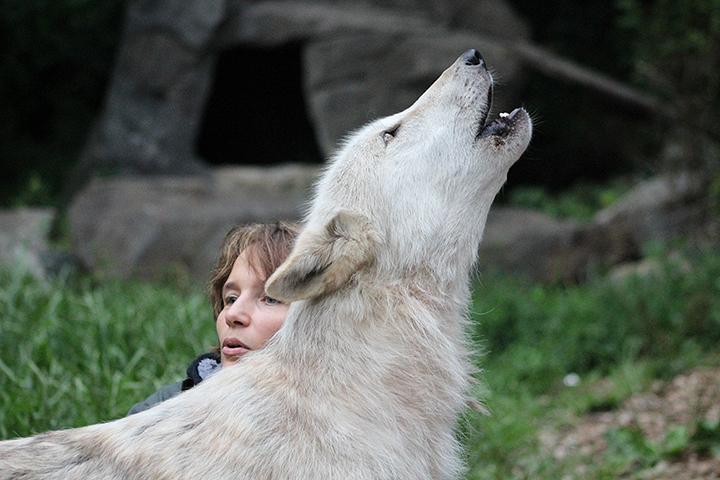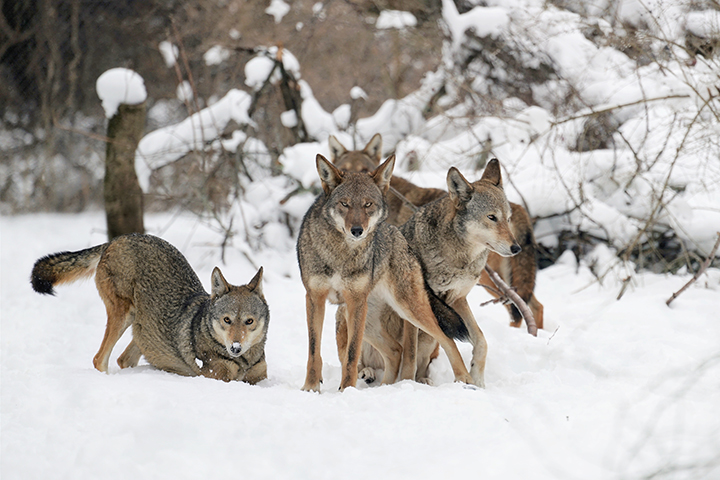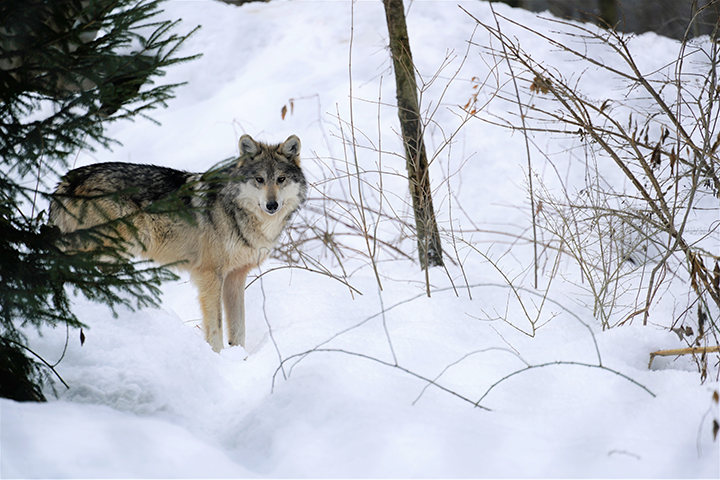Residents near Buck Run in South Salem, NY have more than likely heard a sound that is perhaps one of the most iconic sounds of true wilderness. It’s a sound that has inspired awe and fear for hundreds of generations and has made its way into popular media and folklore in cultures around the world: the howling of wolves.
While otherwise rare, if not impossible, to hear in most of the Eastern US, it’s a very common occurrence at the Wolf Conservation Center (WCC) in South Salem, NY, which is currently home to 30 wolves as part of a thriving conservation program that began with the passion of one extraordinary woman.
 In 1999, WCC Founder Helene Grimaud put her career as a professional classical pianist on hold to establish an educational center to teach people about wolves and their significance, especially with all the fears and fables surrounding them in our culture. Her goal was to use the wolves to inspire love of all living things so we could be better stewards of nature. It was a mom and pop operation, fueled by passion and care for the wolves. Once the wolf center got its grounding and became well established, she stepped back and returned to her career, performing at Carnegie Hall in NYC, the Royal Albert Hall in London, and similar venues across the world. Today, the WCC is contributing to the preservation of two critically endangered species that few have heard of and even fewer have seen in person.
In 1999, WCC Founder Helene Grimaud put her career as a professional classical pianist on hold to establish an educational center to teach people about wolves and their significance, especially with all the fears and fables surrounding them in our culture. Her goal was to use the wolves to inspire love of all living things so we could be better stewards of nature. It was a mom and pop operation, fueled by passion and care for the wolves. Once the wolf center got its grounding and became well established, she stepped back and returned to her career, performing at Carnegie Hall in NYC, the Royal Albert Hall in London, and similar venues across the world. Today, the WCC is contributing to the preservation of two critically endangered species that few have heard of and even fewer have seen in person.
“In the early 2000’s, we were invited to participate in the Species Survival Plan for 2 critically endangered species; the red wolf and the Mexican grey wolf,” said WCC Executive Director Maggie Howell. “Beyond housing and caring for the wolves, our participation means we’re collaborating with a network of zoos, scientists, and state and federal agencies to grow the captive population, augment their genetic diversity, conduct research, and make recommendations for release.”
Conservation in Action
Today, the WCC has 18 Mexican grey wolves and 10 red wolves. These wolves are precious members of their species, as their populations in the wild were nearly extinguished.
Mexican grey wolves were all but extinct in the wild due to over-hunting and conflict with humans, until in 1977 the US Fish and Wildlife Service, in collaboration with the Mexican government, embarked on a plan to conserve the species and launched a captive breeding program with the seven remaining known Mexican grey wolves. The service released the first captive-born Mexican grey wolves back into the wild in 1998. Today, there are roughly 241 individuals in the wild.
 Red wolves have a similar history. They were considered biologically extinct in 1980 and were placed in captivity to eventually release them back into the wild beginning in 1987. The red wolves were part of a pilot program for releasing wolves into the wild, and after that there was the iconic release of timber wolves back into Yellowstone beginning in 1995. The pup cross-foster program also began with red wolves. It’s been court ordered for the re-introduction and recovery planning, and researchers are waiting to see what areas can provide the best habitat, tolerance, and policies for the recovery of the red wolf population. Currently, red wolves are only living in the Northeast area North Carolina.
Red wolves have a similar history. They were considered biologically extinct in 1980 and were placed in captivity to eventually release them back into the wild beginning in 1987. The red wolves were part of a pilot program for releasing wolves into the wild, and after that there was the iconic release of timber wolves back into Yellowstone beginning in 1995. The pup cross-foster program also began with red wolves. It’s been court ordered for the re-introduction and recovery planning, and researchers are waiting to see what areas can provide the best habitat, tolerance, and policies for the recovery of the red wolf population. Currently, red wolves are only living in the Northeast area North Carolina.
“Wolves are a political hot potato, but there has been a re-commitment from the government, and as a result the first known breeding pair in the wild noted for the first time in a while,” said Howell. “The Mexican grey wolf program releases captive-born animals only through the initiative called cross-fostering; when pups no older than 2 weeks old are brought out of the facility, then inserted into wild dens. It takes a lot of coordination, as US Fish and Wildlife Service and the state wildlife agencies have to find where the wild wolves are denning, and it’s a broad, vast wilderness. Then we have to hope the birth of the captive pups line up with the wild newborns.”
In 2019, the WCC participated in this effort by releasing two pups, Hope and Crumbo, into the wild. They were pups of wolves that remain at the center; Trumpet, the mother, and her mate Lighthawk who was moved from Arizona after a conflict between his family and local cattle. “In 2018 or 2019, we had a total of 21 puppies at the facility,” said Howell. “These pups, beyond being adorable, represent the future of the recovery of their species. It gives me goosebumps to think of adults released into the wild. That’s really what it’s all about.”
The red wolf is even more critically endangered. There are only 14 known individuals in the wild. With 10 individuals at the WCC, they are a key program to ensuring the survival of this species in the wild.
Joining the Effort
Visitors to the WCC are not guaranteed to see many of these wolves, as the wolves must not get too accustomed to the presence of humans in order for them to survive in the wild. However, there is a chance to see some Mexican grey wolves and red wolves in the front enclosures if they choose to make themselves known.
Visitors are however guaranteed to see at least two wolves, the ambassador timber wolves Alawa and Nikai. “We want to make sure these are animals that aren’t just living in capacity unless they are forging a connection between our visitors and their wild kin,” said Howell.
 These two white wolves have been forging that connection for years. The result? A community that cares deeply for them and come together for the stewardship of nature.
These two white wolves have been forging that connection for years. The result? A community that cares deeply for them and come together for the stewardship of nature.
“Our community is so supportive,” said Howell. “We have the police and fire department always calling us if there is road kill to feed the wolves, but sometimes even the neighbors would drive up with deer roadkill in the back of their Subaru! Of course, you don’t need to do that in order to help. If you see roadkill in New York, call 914-763-2373 and someone will come pick it up for the wolves.”
To see the wide diversity of programs, live cameras, conservation efforts, and donation opportunities, visit nywolf.org •